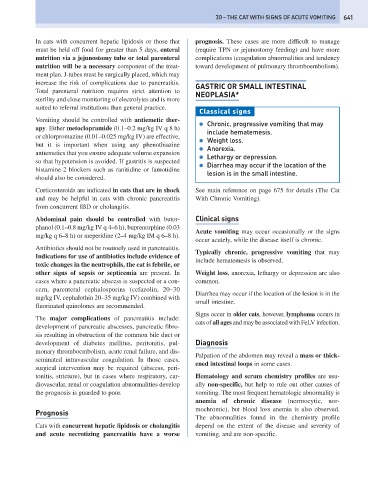Page 649 - Problem-Based Feline Medicine
P. 649
30 – THE CAT WITH SIGNS OF ACUTE VOMITING 641
In cats with concurrent hepatic lipidosis or those that prognosis. These cases are more difficult to manage
must be held off food for greater than 5 days, enteral (require TPN or jejunostomy feeding) and have more
nutrition via a jejunostomy tube or total parenteral complications (coagulation abnormalities and tendency
nutrition will be a necessary component of the treat- toward development of pulmonary thromboembolism).
ment plan. J-tubes must be surgically placed, which may
increase the risk of complications due to pancreatitis.
GASTRIC OR SMALL INTESTINAL
Total parenteral nutrition requires strict attention to
NEOPLASIA*
sterility and close monitoring of electrolytes and is more
suited to referral institutions than general practice.
Classical signs
Vomiting should be controlled with antiemetic ther-
● Chronic, progressive vomiting that may
apy. Either metoclopramide (0.1–0.2 mg/kg IV q 8 h)
include hematemesis.
or chlorpromazine (0.01–0.025 mg/kg IV) are effective,
● Weight loss.
but it is important when using any phenothiazine
● Anorexia.
antiemetics that you ensure adequate volume expansion
● Lethargy or depression.
so that hypotension is avoided. If gastritis is suspected
● Diarrhea may occur if the location of the
histamine-2 blockers such as ranitidine or famotidine
lesion is in the small intestine.
should also be considered.
Corticosteroids are indicated in cats that are in shock See main reference on page 675 for details (The Cat
and may be helpful in cats with chronic pancreatitis With Chronic Vomiting).
from concurrent IBD or cholangitis.
Abdominal pain should be controlled with butor- Clinical signs
phanol (0.1–0.8 mg/kg IV q 4–6 h), buprenorphine (0.03
Acute vomiting may occur occasionally or the signs
mg/kg q 6–8 h) or meperidine (2–4 mg/kg IM q 6–8 h).
occur acutely, while the disease itself is chronic.
Antibiotics should not be routinely used in pancreatitis.
Typically chronic, progressive vomiting that may
Indications for use of antibiotics include evidence of
include hematemesis is observed.
toxic changes in the neutrophils, the cat is febrile, or
other signs of sepsis or septicemia are present. In Weight loss, anorexia, lethargy or depression are also
cases where a pancreatic abscess is suspected or a con- common.
cern, parenteral cephalosporins (cefazolin, 20–30
Diarrhea may occur if the location of the lesion is in the
mg/kg IV, cephalothin 20–35 mg/kg IV) combined with
small intestine.
fluorinated quinolones are recommended.
Signs occur in older cats, however, lymphoma occurs in
The major complications of pancreatitis include:
cats of all ages and may be associated with FeLV infection.
development of pancreatic abscesses, pancreatic fibro-
sis resulting in obstruction of the common bile duct or
development of diabetes mellitus, peritonitis, pul- Diagnosis
monary thromboembolism, acute renal failure, and dis-
Palpation of the abdomen may reveal a mass or thick-
seminated intravascular coagulation. In those cases,
ened intestinal loops in some cases.
surgical intervention may be required (abscess, peri-
tonitis, stricture), but in cases where respiratory, car- Hematology and serum chemistry profiles are usu-
diovascular, renal or coagulation abnormalities develop ally non-specific, but help to rule out other causes of
the prognosis is guarded to poor. vomiting. The most frequent hematologic abnormality is
anemia of chronic disease (normocytic, nor-
mochromic), but blood loss anemia is also observed.
Prognosis
The abnormalities found in the chemistry profile
Cats with concurrent hepatic lipidosis or cholangitis depend on the extent of the disease and severity of
and acute necrotizing pancreatitis have a worse vomiting, and are non-specific.

